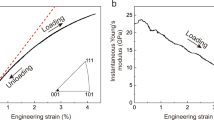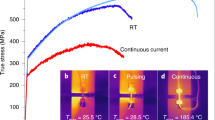Abstract
IT is known that differences exist between deformation produced in metals by steady stress and that due to cyclic stressing1. For example, the lattice distortions revealed by X-ray diffraction patterns and the laws of work-hardening produced by the two modes of stressing are distinctly different. These two types of deformation have been studied extensively but separately. In the work reported here, both steady and cyclic deformation were applied simultaneously, with some striking effects in the resultant behaviour. It was observed that, under the influence of an added cyclic stress, the metal could withstand strains more than 100 per cent greater than those possible with unidirectional straining.
This is a preview of subscription content, access via your institution
Access options
Subscribe to this journal
Receive 51 print issues and online access
$199.00 per year
only $3.90 per issue
Buy this article
- Purchase on Springer Link
- Instant access to full article PDF
Prices may be subject to local taxes which are calculated during checkout
Similar content being viewed by others
References
Wood, W. A., and Segall, R. L., J. Inst. Met., 86, 225 (1958).
Kennedy, A. J., Nature, 178, 810 (1956).
Kemsley, D. S., J. Inst. Met., 87, 10 (1958).
Meleka, A. H., and Evershed, A. V., J. Inst. Met., 88, 411 (1960).
Author information
Authors and Affiliations
Rights and permissions
About this article
Cite this article
MELEKA, A., HARRIS, L. Cyclic-induced Ductility in Zinc. Nature 193, 770–771 (1962). https://doi.org/10.1038/193770a0
Issue Date:
DOI: https://doi.org/10.1038/193770a0
This article is cited by
-
Plastic deformation of aluminum under repeated loading
Metallurgical Transactions A (1975)
Comments
By submitting a comment you agree to abide by our Terms and Community Guidelines. If you find something abusive or that does not comply with our terms or guidelines please flag it as inappropriate.



